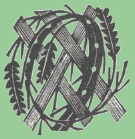
Everyman's Library volumes were issued with dust jackets, from the drab, purely functional early wrappers with their advertisements of other Everyman volumes and Dent series, to the ultimate incorporation of pictorial covers designed to help sell the book as well as protect it. In the images below, the style numbering follows Seymour (Guide 19-34). There are many variations within versions, all of which Seymour has painstakingly catalogued. As it would be impractical to attempt to show all of them, only major variations are illustrated, and then only with representative examples, taken from the collection of Jeffrey S. Anderson, unless otherwise noted.
Click thumbnails to enlarge images
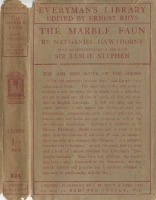 |
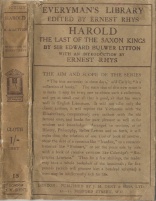 |
| Dent red, priced (1906-11) | Dent black, priced (1911-14) |
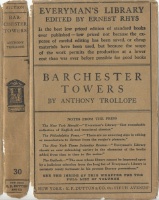 |
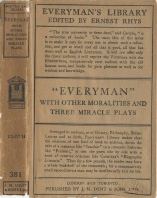 |
| Dutton black, unpriced (1911-1915) | Dent black, unpriced (1915-27) |
Version 1 Jackets (1906-27)
In the early days of Everyman's Library, the dust jackets were drab and unattractive, obviously intended only to protect the binding prior to sale, after which it was expected that the purchaser would discard it in order to display the ornate gilt spine. Dents used these jackets to advertise not only other Everyman volumes, but also other Dent series. All things considered, it is a wonder that any of these jackets have survived. They are scarce, but can still be found. They are usually associated with binding Style 1, but may occasionally be found wrapped around Style 2 bindings. The same jackets were used, with 'Leather' instead of 'Cloth' printed on the spine, for the Style 1 leatherette volumes (Guide 20), but these are very rare.
All of the Version 1 jackets are characterized by the sundial device on the spine. This is such a finely cut device that seldom is it clearly printed on the paper, but at the top one can clearly distinguish the Agnus Dei image used by Dents in the Temple Shakespeare and Temple Bible series. This lamb symbol is part of the coat of arms of the Middle Temple, one of the four London Inns of Court. At the bottom is the epigram, "Shadows we are and like shadows depart", which appears on an actual sundial that dates from 1686, located on a wall in Pump Court in the Middle Temple region of the City of London.
The earliest jackets were printed in red, and the example at left is of the first jacket issued in 1906, with "The Aim and Scope of the Series" beneath the title. Beginning in 1911, black ink was used instead, which certainly increased legibility. Due to rising prices after the Great War, Dents left off printing the price on the jacket in 1915. From 1908-15, Dutton had separately printed jackets, identified by their name alone at the foot of the spine, and by the lack of the British currency markings. After 1915, when Dents also stopped printing the price, the separate Dutton jackets apparently stopped being printed (Guide 25).
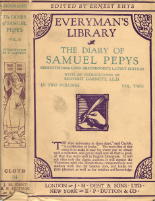 |
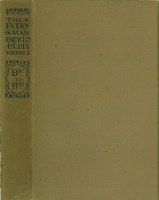 |
| Hand & Quill Jacket (1926-27) | Source: Charles Bowers Encyclopedia Jacket (1913-?) |
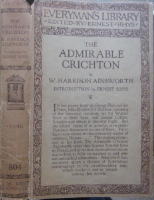 |
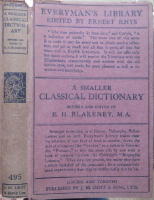 |
| Source: Mike Greenleaf Interim jacket (1925-26?) |
Source: Mike Greenleaf Reference jacket (early 1920s?) |
Other Early Jackets
The cream-colored "hand and quill" dust jacket is seldom seen and was apparently an experimental or transitional step towards the redesign of the Version 2 jacket (Guide 24).
Þ
Seymour had originally concluded (Guide 7) that The Everyman's Encyclopedia was issued without dust jackets, based on never having seen one in his many years of collecting and the fact that many illustrations of sets were without them, but this example from the collection of Charles Bowers of Ontario, Canada proves the contrary.
Þ
This attractive jacket for The Admirable Crichton (No. 804) "is the only example I have seen of that jacket," writes Seymour via email. "Sequence is just guesswork but it would seem to be an experiment slightly before the hand and quill. It might be unique since they were clearly casting about for a new design."
Þ
Dating the "dandelion jacket" is also rather difficult (see Guide 25). The purple tint is consistent with the color of the binding for the Reference Section. So far we know only that Roget's two-volume Thesaurus (Nos.630, 631), the Classical Atlas (No. 451), and the Classical Dictionary (No. 495) exist in this jacket, though it would seem likely the other reference titles were issued thus as well.
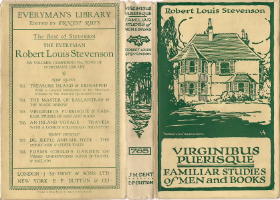 |
|
| Source: Terry Seymour Virginibus Puerisque (No. 765) |
|
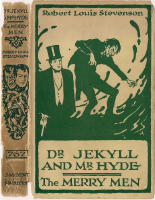 |
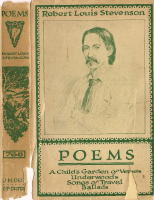 |
| Source: Terry Seymour Dr. Jekyll and Mr. Hyde (No. 767) |
Source: Terry Seymour Poems (No. 768) |
Stevenson Jackets
After legal wrangling with the Stevenson estate, Dent won the right to combine Stevenson's shorter works while paying only one royalty per volume, rather than a royalty for each work. Thus in 1925 Dent produced seven volumes numbered 763-769 issued in special Stevenson-themed dust jackets (see Guide 37). These jackets are very hard to find. View a bookmark advertisement for this set.
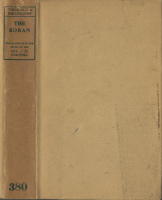 |
|
| Early Library Jacket (1906-27) | |
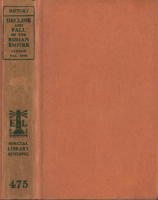 |
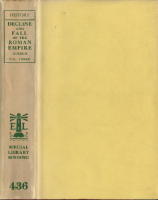 |
| Later Library Jackets (1928-39) |
|
Library Jackets
The dust jacket for the buckram library binding had no decorations on either front or back, and no advertisements. The section, title, and author appear at the head of the spine, and a stencil-like serial number at the foot (Guide 31).
When the Version 2 jackets were introduced in 1928, the library jacket was updated to include the "EL" lighthouse icon as well, with the words "Special Library Binding" added beneath. In addition to the standard beige color, these later jackets also appear in yellow and orange. They continued to be used until 1939, when Dents ceased producing the library binding altogether, even after the Ravilious jackets were introduced with the 1935 style change. In fact, the jackets shown are from the final, Style 3 library bindings.
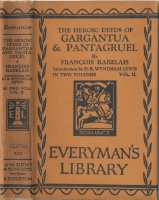 |
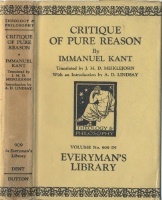 |
| Version 2 (1928-32) | Version 3 (1933-34) |
Versions 2 and 3 Jackets (1928-1934)
The Version 2 jacket was introduced when the binding style changed (Style 2) in 1928. A new lighthouse logo designed by Reginald Knowles appears on the spine, and the names of both Dent and Dutton are printed at the foot. The jackets appear in different colors, but these are oddly not matched to library section. Instead, the section is indicated on the cover by a specific icon, also designed by Knowles. To see the complete set of these images, see Knowles Jacket Devices.
The Version 3 jacket is very similar to the preceding, but the scrollwork on the spine and cover has changed, and the lighthouse was removed from the spine. For a complete discussion of these two jacket styles, see Guide 25-7. One will also occasionally come across either one of these jackets on a binding Style 3 volume.
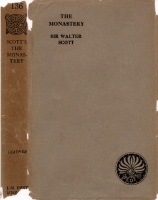 |
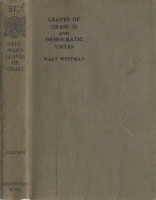 |
| Source: John B. Krygier Dent |
Dutton |
| Later Leather Jackets (1920-29) |
|
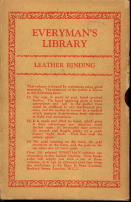 |
| Leather Slipcover (1929-40) |
Later Leather Jackets (1920-29)
The leatherette bound volumes were originally wrapped in Version 1 dust jackets (Guide 20). With the switch to the sturdier new leatherette binding in 1920-21, this plain gray jacket came into use, with the Celtic knotwork spine emblem on the spine matching the one on the new binding (Guide 31).
In 1929 the grey jackets were replaced with a cellophane wrapper in a flimsy cardboard slipcase, a style used until the leather bindings were discontinued around 1940.
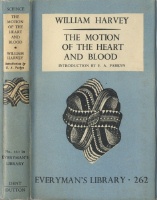 |
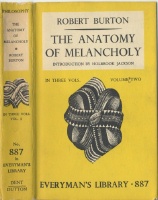 |
| Knot design jacket, small number on spine (1935-38) |
Knot design jacket, large number on spine (1938-52) |
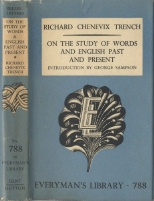 |
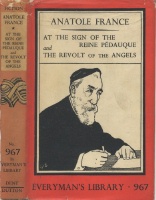 |
| "EL" shell design jacket (1945-52) | Pictorial jacket (1941-42) |
Version 4 Jackets (1935-1952)
The Version 4 jacket was introduced when the binding style changed (Style 3) in 1935. The covers were designed by Eric Ravilious. An abstract knot design appears on the cover and on the spine in the first two variants, but they differ in the size of the number on the spine. Beginning around 1945, the "EL in a shell" design began to appear concurrently with the knot design. The pictorial cover first appeared in No. 967 (as shown), and Seymour has other examples in his collection, all in the range of Nos. 967-971, after which they were no longer produced, probably due to wartime economy measures. The Version 4 colors varied but again there seems to be no clear assignment of colors to sections, although all the jackets I have seen for the Fiction section are red, and for the Poetry & Drama section are green.
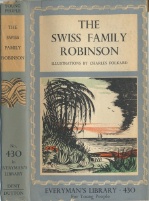 |
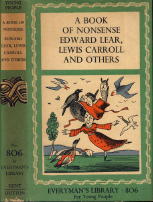 |
| Children's Jackets |
|
Children's Jackets (1949-1960)
In the early 1950s, Dents began to produce pictorial covers for children's titles, with the same basic format as the Version 4 jackets. They issued 24 volumes in the Young People section with these jackets until 1960 or so, after most of these titles had been transitioned out of the Everyman's Library and into the Children's Illustrated Classics series. Even though this extended into the large format binding period, the pictorial jackets continued to be produced until the warehouse inventories of the Style 3 bindings were exhausted.
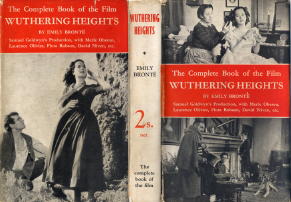 |
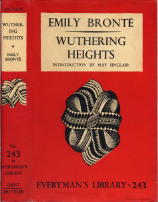 |
| Outer promotional jacket (1939) | Version 4 inner jacket |
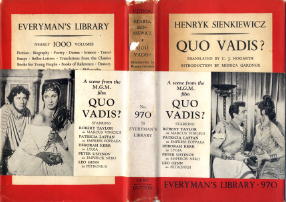 |
| Wraparound band on version 4 jacket (1952) |
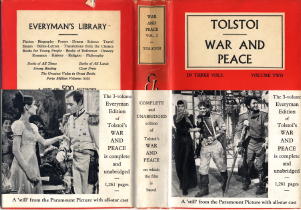 |
| Wraparound band on version 5 jacket (1957) |
Movie Tie-in Jackets (1924-1965)
Dents occasionally produced wraparound advertisements promoting BBC radio broadcasts, television programs, and movies in hopes of increasing book sales by the association (Guide 33-34; History 17-18). The earliest instance was in 1924 for No. 422, Hugo's Hunchback of Notre Dame, featuring a photograph of Lon Chaney in the Universal Studios silent film.
On No. 243, Bronte's Wuthering Heights, a complete wrapper was used for the 1939 Samuel Goldwyn film starring Laurence Olivier, Merle Oberon, and David Niven.
On No. 970, Sienkiewicz's Quo Vadis?, a wraparound strip promoted the 1951 MGM film starring Robert Taylor, Deborah Kerr, and Peter Ustinov.
On Nos. 525-527, Tolstoy's three volume War and Peace, different wraparound strips were used to promote the 1956 Paramount production. Each wraparound has two of three different scenes from the film: vol. 1 front has Audrey Hepburn and Mel Ferrer, back has Herbert Lom on horseback as Napoleon; vol. 2 front (shown at left) has Hepburn and I believe Henry Fonda plus one other, back has Hepburn and Ferrer; and vol. 3 front has Herbert Lom and back has Hepburn and the soldiers. The effect is that face up or face down, all three volumes display different images.
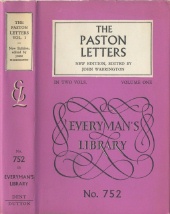 |
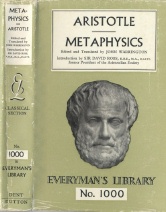 |
| Early version (1953-57) | Special design in 1956 for the 1000th volume |
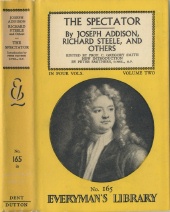 |
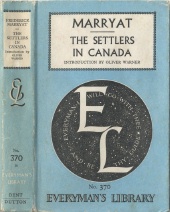 |
| Pictorial jacket (1957-60) | Another variation |
Version 5 Jackets (1953 through mid-1960s)
The transition to the larger crown octavo binding in 1953 obviously necessitated a complete redesign of the dust jackets as well. A script "EL" adorns the spine, and the simple cover has "Everyman's Library" surrounded by scrollwork. Initially only two colors were used: red wrapper and binding for the lower price, and blue wrapper and binding for the higher price. In 1956, the jacket for Aristotle's Metaphysics had a special pictorial color to celebrate the publication of the 1000th volume.
By the end of 1956, Dents saw the need for four pricing levels, color-coded from low to high as red, blue, green, and yellow. In 1957, illustrations begin to appear on the front cover, though not all jackets had them. In 1962, they introduced a fifth lilac-colored wrapper to signify the highest price, with the fourth color being either yellow or brown, and in 1965, a sixth white-colored wrapper was introduced for the highest price. In addition to the color, the inside front flap contained a legend of corresponding price category symbols.
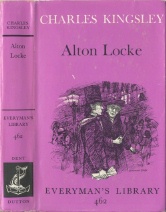 |
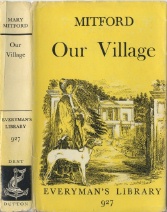 |
| Pictorial jackets (1960-70) |
|
Version 6 Dust Jackets (1960-70)
Circa 1960, when Dents began commissioning illustrative artwork for the jackets, the jacket format was also changed to a more modern looking design. The title box was removed, and instead of the script "EL" on the spine, a white-on-black anchor and dolphin colophon was used at the foot. The colors and price category symbols continued as before. Some of these jackets continued to be used on the post-1970 Style 5 bindings (plain endpapers), but by that time the price categories no longer applied, and though the front flap price symbol legend was present, it was crossed out.
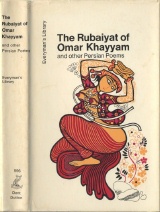 |
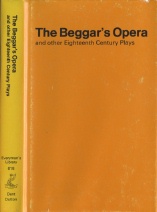 |
| 1971-77 | 1978 |
Version 7 Jackets (1970-78)
About the same time as the introduction of binding Style 5, with its plain endpapers and cheaper construction, the jacket was also redesigned. A smaller anchor and dolphin device was employed, with varying positions of the serial number and the "Everyman's Library" line. By 1978, Dents dispensed with cover artwork altogether.
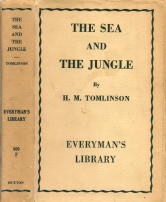 |
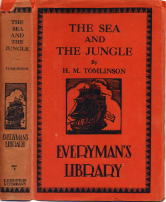 |
| Plain cream jacket | Clipper ship jacket |
| American Edition (1927-28) |
|
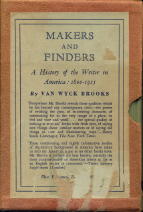 |
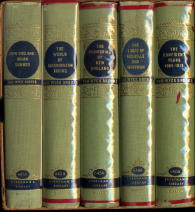 |
| Makers and Finders boxed set (1955). | |
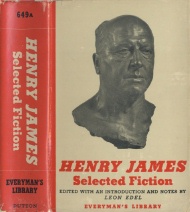 |
|
| New American Edition Henry James volume (1953). | |
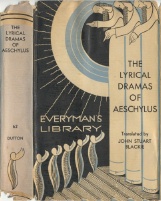 |
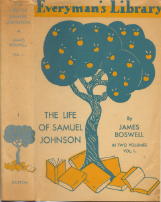 |
| Dutton "Modern Dress" Jackets (1931-32) |
|
American Edition Jackets
In 1927-28, Dutton released (only in the United States) six titles numbered 800A-800F with different bindings and jackets (see Guide 18-19). One style was the cream-color jacket depicted at left. The other style, appearing in various colors, had a sailing ship on the cover and spine. Later, these titles were released in Modern Dress jackets (see below).
Þ
The New American Edition comprised 32 titles published by Dutton from 1950 to 1955. Only the Henry James volume (No. 649A) had a dust jacket. The others came in a cellophane wrapper bordered in narrow red tape. The five volume Van Wyck Brooks series Makers and Finders (Nos. 641A, 642A, 645A, 648A, and 650A) was offered in 1955 as a boxed set for $10.
Þ
"In an apparent attempt to sell more books through colorful packaging" (History 15) and contemporary design, Dutton in the early 1930s issued the Everyman's Library in Modern Dress jackets for some 176 volumes (listed in Guide 32). There are ten different designs which occurred in various colors and were not matched to sections (History 15-16). The images shown represent the "Staircase" and "Tree" designs. For more examples, see Dutton Modern Dress Jackets.
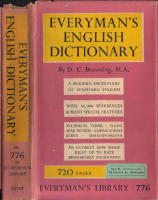 |
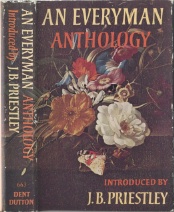 |
| Source: Michael Penberthy Everyman's English Dictionary (1942) |
An Everyman Anthology, Diamond Jubilee (1966) |
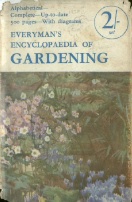 |
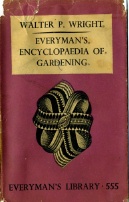 |
| Source: Terry Seymour Outer jacket |
Source: Terry Seymour Standard inner jacket |
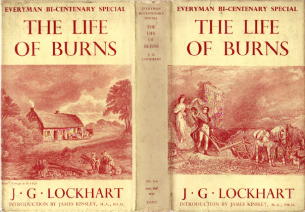 |
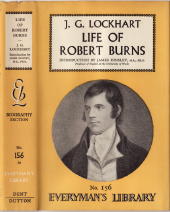 |
| Source: John Krygier Outer jacket |
Source: John Krygier Standard inner jacket |
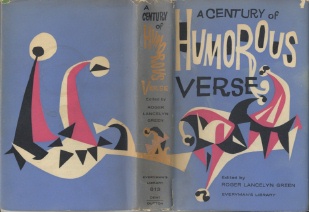 |
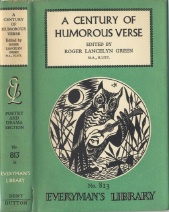 |
| Outer jacket |
Standard inner jacket |
Special Jackets
Everyman's English Dictionary (No. 776) in its earliest state (1926) is devilishly difficult to find despite a fairly large number printed, but this 1942 revised edition is more common. It is rare to find it with a dust jacket, however, and though it is very ugly, Mr. Penberthy (of Austinmer, NSW, Australia) is nonetheless proud of it, and the rest of us are duly envious.
Þ
The Everyman Anthology (No. 663) jacket was specially designed for the Diamond Jubilee of the Everyman's Library in 1966. The cover is a detail from a still-life by Dutch painter Rachel Ruysch (1664-1750).
Þ
Everyman's Encyclopedia of Gardening (No. 555) is an early (1932) example of Dent's wrapping a volume in two dust jackets, an outer decorative one, and a standard cover on the inside. This volume has a rather involved publishing history at Dent (see Seymour 285).
Þ
In 1959, Dents celebrated the 200th anniversary of the birth of Robert Burns by reissuing Lockhart's Life (No. 156) with a new introduction by Prof. James Kinsley and in this attractive outer wrapper over the standard Version 5 jacket.
Þ
A Century of Humorous Verse (No. 813) was a new collection also published in 1959 and wrapped in two dust jackets. The inner one is the standard Version 5 jacket, while the specially designed outer wrapper bears the whimsical artwork of Alexander H. Williamson.
